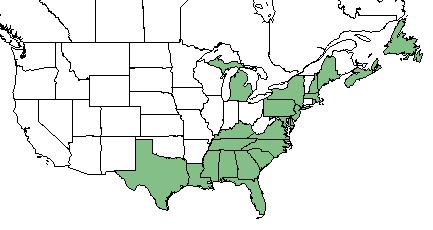Difference between revisions of "Proserpinaca pectinata"
m |
|||
| Line 28: | Line 28: | ||
==Ecology== | ==Ecology== | ||
===Habitat=== <!--Natural communities, human disturbed habitats, topography, hydrology, soils, light, fire regime requirements for removal of competition, etc.--> | ===Habitat=== <!--Natural communities, human disturbed habitats, topography, hydrology, soils, light, fire regime requirements for removal of competition, etc.--> | ||
| − | ''P. pectinata'' occurs in bogs, savannas, ditches, and other wet places.<ref name="Weakley 2015"/> Along New York pond shorelines, this species is found on areas of organic exposed pond bottoms and permanently flooded zones.<ref name="Zaremba & Lamont 1993">Zaremba RE, Lamont EE (1993) The status of the coastal plain pondshore community in New York. Bulletin of the Torrey Botanical Club 120(2):180-187.</ref> In New Jersey pinelands, ''Proserpinaca pectinata'' | + | ''P. pectinata'' occurs in bogs, savannas, ditches, and other wet places.<ref name="Weakley 2015"/> Along New York pond shorelines, this species is found on areas of organic exposed pond bottoms and permanently flooded zones.<ref name="Zaremba & Lamont 1993">Zaremba RE, Lamont EE (1993) The status of the coastal plain pondshore community in New York. Bulletin of the Torrey Botanical Club 120(2):180-187.</ref> In New Jersey pinelands, ''Proserpinaca pectinata'' occurred in 20% of ponds.<ref name="Laidiig 2012">Laidig KJ (2012) Simulating the effect of groundwater withdrawals on intermittent-pond vegetation communities. Ecohydrology 5:841-852.</ref> |
===Phenology=== <!--Timing off flowering, fruiting, seed dispersal, and environmental triggers. Cite PanFlora website if appropriate: http://www.gilnelson.com/PanFlora/--> | ===Phenology=== <!--Timing off flowering, fruiting, seed dispersal, and environmental triggers. Cite PanFlora website if appropriate: http://www.gilnelson.com/PanFlora/--> | ||
Revision as of 20:11, 31 January 2018
| Proserpinaca pectinata | |
|---|---|

| |
| Photo by John Gwaltney hosted at Southeastern Flora.com | |
| Scientific classification | |
| Kingdom: | Plantae |
| Division: | Magnoliophyta - Flowering plants |
| Class: | Magnoliopsida - Dicots |
| Order: | Haloragales |
| Family: | Haloragaceae |
| Genus: | Proserpinaca |
| Species: | P. pectinata |
| Binomial name | |
| Proserpinaca pectinata Lam. | |

| |
| Natural range of Proserpinaca pectinata from USDA NRCS Plants Database. | |
Common Names: feathery mermaid-weed;[1] combleaf mermaidweed[2]
Contents
Taxonomic Notes
Description
Proserpinaca pectinata is a dioecious perennial that grows as a forb/herb.[2]
Distribution
This species occurs from Nova Scotia, south to southern Florida, and westward to western Louisiana. While it is primarily found along the coastal plain, it occurs inland, as far as Tennessee.[1]
Ecology
Habitat
P. pectinata occurs in bogs, savannas, ditches, and other wet places.[1] Along New York pond shorelines, this species is found on areas of organic exposed pond bottoms and permanently flooded zones.[3] In New Jersey pinelands, Proserpinaca pectinata occurred in 20% of ponds.[4]
Phenology
In the southeastern and mid-Atlantic United States, flowering occurs from June through October.[1]
Conservation and Management
Cultivation and restoration
Photo Gallery
References and notes
- ↑ 1.0 1.1 1.2 1.3 Weakley AS (2015) Flora of the Southern and Mid-Atlantic States. Chapel Hill, NC: University of North Carolina Herbarium.
- ↑ 2.0 2.1 USDA NRCS (2016) The PLANTS Database (http://plants.usda.gov, 31 January 2018). National Plant Data Team, Greensboro, NC 27401-4901 USA.
- ↑ Zaremba RE, Lamont EE (1993) The status of the coastal plain pondshore community in New York. Bulletin of the Torrey Botanical Club 120(2):180-187.
- ↑ Laidig KJ (2012) Simulating the effect of groundwater withdrawals on intermittent-pond vegetation communities. Ecohydrology 5:841-852.